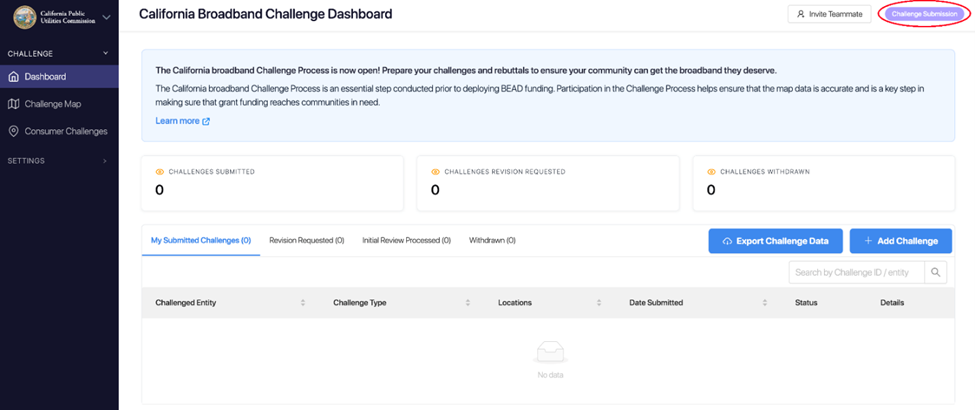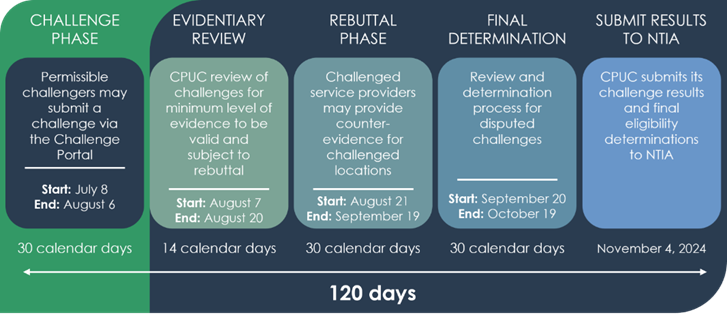BEAD Challenge Process
BEAD Final Determination
Consistent with the BEAD Challenge Process Policy Notice (v1.3) transparency requirements, the CPUC is posting all submitted challenges and rebuttals, including:
- The nonprofit, unit of local government or provider making the challenge
- The type of the challenge (e.g., availability)
- A summary of the challenge
- A summary of the rebuttal(s) to the challenge
View all submitted challenges and rebuttals here
Challenge Codes
A - Availability
B - Business service only
S - Speed
P - Planned service
L - Latency
N - Not part of enforceable commitment.
E - Enforceable commitment
C - CAI: Location is a CAI
R - CAI: Location is not a CAI
G - CAI: Qualifying broadband unavailable.
Q - CAI: Qualifying broadband available.
V - DSL
F - Fixed wireless
Disposition of Challenge
I – incomplete (the challenge data was incomplete and the challenger did not provide the missing data in time; thus, the challenge could not be submitted for rebuttal); considered “rejected”
N – the provider did not respond within the rebuttal deadline; considered “sustained”
A – the provider agreed with the challenge; considered “sustained”
S – sustained (after rebuttal and evaluation)
R – rejected (after rebuttal and evaluation)
M – moot due to another successful challenge for the same location
The BEAD Challenge Process
The BEAD Challenge Phase is live in the BEAD Challenge Portal as of July 8, 2024, at 8:00 a.m. PST and will end on August 6, 2024, at 11:59 p.m. PST. During this 30-day window, permissible challengers (units of local and Tribal governments, nonprofits, and broadband service providers) will be able to challenge the existing BEAD Challenge Process map by submitting evidence through the Portal when specific locations may not be accurately represented as unserved, underserve, or served. At the end of the Challenge Process (subject to NTIA approval), a final map of locations eligible for BEAD funding will be published. When you log in, you will see “Challenge Submission” in the upper right corner to indicate that the Challenge Phase is open and challenges are being accepted.
Individuals may also submit evidence using the BEAD Consumer Challenge Website and this will be made available for permissible challengers to submit on their behalf through the Portal.
Submit Challenge Here: BEAD Challenge Portal
The User Guide has been updated to Version 1.1 (July 5, 2024) and can be accessed from the Permissible Challengers page.

The BEAD Challenge map and data reflect Version 4 of the Broadband Serviceable Locations Fabric, released on May 14, 2024 (showing National Broadband Map Availability Data as of December 31, 2023), the result of the deduplication process, and incorporate California’s Pre-Challege modifications.
The BEAD Challenge Process will determine which locations and community anchor institutions within the state are eligible for BEAD funding. This is an opportunity to provide feedback to NTIA on the FCC National Broadband Map that will inform locations eligible for BEAD funding.
Program rules require that the Federal Communication Commission’s (FCC) broadband map will serve as the starting point for service status, and the FCC’s definitions for “unserved” and “underserved” will be used and prioritized in the following order:
- Unserved locations are defined as Broadband Serviceable Locations (BSL) that lack access to “Reliable Broadband Service” at speeds of at least 25 Mbps downstream and 3 Mbps upstream and at latency levels low enough to support real-time, interactive applications.
- Underserved locations are defined as BSLs that lack access to “Reliable Broadband Service” at speeds of at least 100 Mbps downstream and 20 Mbps upstream and at latency levels low enough to support real-time, interactive applications.
What is the Challenge Process?
Challengers can submit evidence to change the service status (e.g., from unserved to underserved, from served to unserved, etc.) of any individual location or group of locations once the Challenge Process has begun. These location classifications will play a critical role in the distribution of BEAD funding, as the program will give first funding priority to unserved locations, followed by underserved locations as second priority, and community anchor institutions (CAI) as third. There will be a 30-day period in which eligible challengers will be able to submit challenges to the CPUC via a web portal.
Per the NTIA, eligible challengers include:
- Local governments
- Tribal governments
- Nonprofit organizations
- Broadband service providers
Can individuals also participate in the Challenge Process?
While NTIA requirements don't allow individuals to submit challenges directly, Californians will play an important role in the challenge process by identifying inaccuracies and working with eligible participating nonprofits or local governments to challenge the maps through the BEAD Consumer Challenge website. More information to come.
Overall Challenge Process Timeline
The Challenge Phase is the first stage of the 120-day Challenge Process. Permissible challengers (units of local and Tribal governments, nonprofits, and broadband service providers) will need to register to submit a challenge or submit on behalf of individuals. Registration will remain open through the Rebuttal Phase to allow challenged Service Providers to register and provide counterevidence to rebut challenged locations. For technical assistance with the Portal, please contact cahelpdesk@ready.net.

Types of Challenges
The BEAD Challenge Process accommodates several types of challenges. Challenges will be officially submitted via the Challenge Portal, where registered permissible challengers will be able to select locations, select a challenge type, and upload corresponding evidence. Further information on required evidence and acceptable challenge types can be found in NTIA’s BEAD Challenge Process Policy Notice. Types of challenges include:
This challenge provides evidence to change or challenge the current classification of a location as an unserved or underserved location eligible for BEAD funds based on broadband serviceable data. This may include:
- Availability – if the listed broadband service is not available at the reported location.
- Speed – if the actual speed of service falls below the unserved or underserved thresholds but is reported as a higher speed.
- Latency – if the round-trip latency of the broadband service exceeds 100 milliseconds.
- Business service only – if the location is residential, but the service offered is marketed or available only to businesses.
- Data cap – if the only service plans marketed to a consumer impose a monthly data cap of below 600GB.
- Technology – if the technology indicated at a location is incorrect.
This challenge provides evidence about whether a location should be classified as a CAI. The categories of locations that classify as CAIs in California are defined in NTIA’s BEAD Challenge Process Policy Notice.
In this challenge, a broadband provider (or other eligible provider) offers convincing evidence that it is currently building out broadband to challenged locations without a government subsidy or is building out broadband offering performance beyond the program requirements.
Planned Service challenges enable broadband providers to demonstrate that they have begun construction to provide services offering speeds of at least 100/20 Mbps to BSLs and will begin offering those services by June 30, 2024.
Key Dates
- June 17, 2024 – Publication of Eligible Locations (map), launch of Consumer Challenge website, and availability of data sets containing unserved locations, underserved locations, and CAIs.
- Week of June 24th - The final map and data downloads will be released here the week of June 24, 2024.
- July 8, 2024 – Challenge Phase (start of Challenge Process)
- August 7, 2024 – Evidentiary Review
- August 21, 2024 – Rebuttal Phase
- September 20, 2024 – Final Determination Phase
- November 4, 2024 – Submit results to NTIA to approve or reverse determinations
Office Hours
The CPUC will hold a series of office hours for live questions on the BEAD Challenge Process. Dates and times are posted on the BEAD Events page for registration.
General BEAD Program Information
For more information on the Challenge Process, the CPUC launched a Challenge Process webpage where permissible challengers can find information about the Challenge Process as it becomes available and register for informational Events. Additionally, we will be updating the BEAD Frequently Asked Questions page in the coming days and weeks to capture the questions you’ve asked during our webinars or sent to the BEAD@cpuc.ca.gov email.
Want to get involved?
- Sign up to receive updates via the CPUC email list, including announcements on upcoming events and learning opportunities.
- Review the California BEAD Challenge Process, outlined in the CPUC’s approved Initial Proposal Volume I.
- Reach out to the CPUC with any questions on the Challenge Process. Emails can be sent to: BEAD@cpuc.ca.gov. Responses will be posted online on the FAQs page.
- For permissible challengers, it is encouraged to obtain a Tier D or Tier E CostQuest License, depending on the organization type. More information can be found here: Location IDs and Tier E Licenses and CostQuest Licensing | BroadbandUSA (doc.gov)
